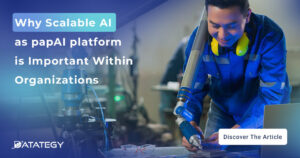Why Scalable AI as papAI platform is Important Within Organizations...
Read MoreThe AI platform that reduces
the carbon footprint of your Data projects
Table of Contents
ToggleWhen people talk about artificial intelligence, they may not think about the environmental impact of algorithmic models. It’s normal that the focus is mostly on processes and cost optimisation but the impact of AI on the environment should not be denied today. Indeed, according to one study, some algorithms produce as much CO2 as a car does during their lifetime.
How do algorithms generate CO2? And how can we reduce their impact on the environment?

Data storage : Highly polluting data centers
Major advances in new technologies have made it possible to store large volumes of data. To support this trend, cloud providers such as OVH and Azure are offering increasingly cheaper storage and computing costs.
Companies can now generate large amounts of data with the computing power to accelerate their prototyping of predictive models.
The cost of storing data and the power of algorithms have thus enabled the democratization of AI and Machine Learning. Indeed, according to a survey conducted by CCS Insight, around 80% of companies surveyed have already used AI or are experimenting AI.
However, storing data requires significant energy resources to carry out the processing of those calculations. What is the impact of this computational processing on the environment? What can we expect in the future?
Artificial Intelligence: a significant carbon footprint
Machine Learning algorithms consume a significant amount of energy to generate the computational processes. Indeed, the massive storage of data has generated a significant buzz and bad press around AI. The ease of access to data storage has led to the development of increasingly complex algorithms, which means that more and more computation is required and thus a considerable increase in CO2 emissions. For example, to train an algorithm on natural language, the equivalent of 355 years of calculation were necessary on a single processor. In terms of CO2 emissions, this is equivalent to driving a new car 700,000 km.
Moreover, the environmental weight of data centers is constantly evolving until it reaches more than 86% of the total digital footprint by 2040. (source: LesEchos)
The Reality of AI Consumption in Business
Contradictory issues for companies
While optimizing operational efficiency and improving customer experiences are still some of the major objectives for many companies, environmental topics are more and more important. The environmental issue brings a lot of interest as it has a strong impact not only on brand image but also on financial costs.
The paradox encountered by these companies is the willingness to implement use cases to optimize carbon emissions by using AI that actually generates a significant carbon footprint. Therefore, the positive effects generated by the use case are canceled out by the CO2 generated by the computational processing of the algorithms.
In the future, companies should think about the implementation of their use case, including the choice of cloud providers but also the choice of the AI platform.
Moving towards a more sustainable use of AI
A few years ago, a consortium of companies set up an open source platform, called Code Carbone, to help companies measure the impact of their code and algorithms, and thus measure the carbon footprint of their activity. Through the platform, it is possible to measure the CO2 emissions of one’s work and to have an equivalence with simple indicators, notably the number of kilometers traveled by a car. This consortium aims to make companies aware of their use of AI, in order to commit them to an ethical AI.
Nevertheless, it is not enough to use tools measuring the impact of one’s work, one must also think about the tools used to minimize the impact of one’s code. Indeed, not all AI platforms adopt an ethical approach. Some of these platforms generate a significant amount of data storage, particularly due to the computational processes carried out. Consequently, the choice of AI platform used to implement these use cases will have a significant impact on data storage, and therefore on its carbon footprint.
Datategy’s papAI allows to measure the equivalence in terms of CO2 emitted and the renewable energy needed to perform an intermediate processing. This approach allows developers to be aware of the impact of their work on the environment, thanks to the equivalence in terms of CO2 emissions that the processing of a calculation represents. For example, the data workflow generated to measure customer churn prediction represents the energy consumption of a dwelling over a day. Through this, it is possible to deduce the cost of each calculation process and thus think of a method to reduce costs.
The use of the papAI platform allows for a more responsible approach than some platforms. Instead of storing all the intermediate data, which generates high storage costs and carbon emissions, papAI stores only part of the intermediate data. Indeed, intermediate data does not need to be systematically stored.The papAI platform will judge the importance of these processes based on the computation time that was required on previous datasets. If a computational process has taken 24 hours, it will be more favourable to store this data. This approach allows an intelligent choice of data and processing to be stored. Through the papAI platform, it is possible to build your own processing scenario to group together lots of small processes and transmit the data from one step to another without the need to be stored.
With this approach, papAI allows to simplify the processing flow, to optimize storage and to reduce the computation time which generates a significant cost. The papAI platform thus adopts a Green by Design approach in line with the environment.
Use AI more responsibly and join the green and ethical AI revolution with papAI.
Discover our papAI platform
Recommended articles
Why is anticipating consumer behavior, the Key to Success ?
In a market where the consumer can choose from a...
Read MoreWhy AIOps Is Key to Cyber Threat Detection in Defense?
Why AIOps Is Key to Cyber Threat Detection in Defense?...
Read More

